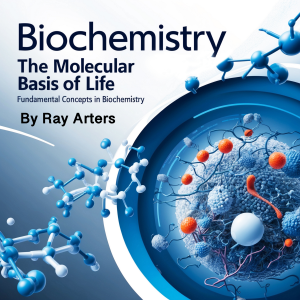

Biochemistry
Ray Arters
This audiobook is narrated by a digital voice.
At the heart of every living organism lies a complex orchestra of chemical reactions, each playing its part in the grand symphony of life. Biochemistry, the study of chemical processes within living systems, reveals how the simple elements of the periodic table combine to create the extraordinary complexity we observe in biological systems. From the smallest bacteria to the largest mammals, all life shares fundamental chemical principles that govern existence itself.
The story of biochemistry begins with carbon, the versatile element that forms the backbone of all organic molecules. Carbon's unique ability to form four stable covalent bonds allows it to create an almost infinite variety of molecular structures. These carbon-based molecules, combined with hydrogen, oxygen, nitrogen, phosphorus, and sulfur, form the primary building blocks of life. This select group of elements, often remembered by the acronym CHNOPS, comprises over 95% of the mass of most living organisms.
Water, though seemingly simple with its H2O formula, plays an indispensable role in biochemical processes. Its polar nature allows it to dissolve a vast array of biological molecules, earning it the title of the "universal solvent." The hydrogen bonds formed between water molecules create unique properties such as cohesion, adhesion, and high specific heat capacity. These characteristics enable water to moderate temperature changes in living systems, transport nutrients and waste products, and provide the medium in which most biochemical reactions occur.
Duration - 43m.
Author - Ray Arters.
Narrator - Digital Voice Archie G.
Published Date - Saturday, 18 January 2025.
Copyright - © 2025 Ray Arters ©.
Location:
United States
Description:
This audiobook is narrated by a digital voice. At the heart of every living organism lies a complex orchestra of chemical reactions, each playing its part in the grand symphony of life. Biochemistry, the study of chemical processes within living systems, reveals how the simple elements of the periodic table combine to create the extraordinary complexity we observe in biological systems. From the smallest bacteria to the largest mammals, all life shares fundamental chemical principles that govern existence itself. The story of biochemistry begins with carbon, the versatile element that forms the backbone of all organic molecules. Carbon's unique ability to form four stable covalent bonds allows it to create an almost infinite variety of molecular structures. These carbon-based molecules, combined with hydrogen, oxygen, nitrogen, phosphorus, and sulfur, form the primary building blocks of life. This select group of elements, often remembered by the acronym CHNOPS, comprises over 95% of the mass of most living organisms. Water, though seemingly simple with its H2O formula, plays an indispensable role in biochemical processes. Its polar nature allows it to dissolve a vast array of biological molecules, earning it the title of the "universal solvent." The hydrogen bonds formed between water molecules create unique properties such as cohesion, adhesion, and high specific heat capacity. These characteristics enable water to moderate temperature changes in living systems, transport nutrients and waste products, and provide the medium in which most biochemical reactions occur. Duration - 43m. Author - Ray Arters. Narrator - Digital Voice Archie G. Published Date - Saturday, 18 January 2025. Copyright - © 2025 Ray Arters ©.
Language:
English
Start
Duration:00:43:13